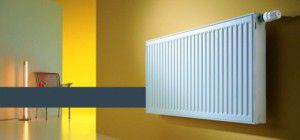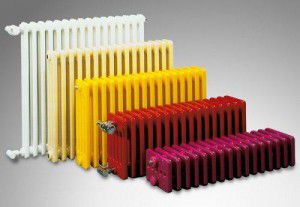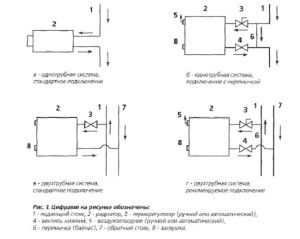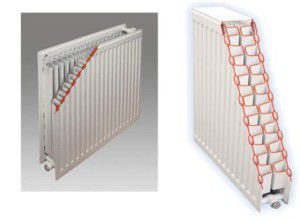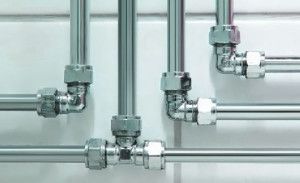The choice of components for the heat supply system will affect its efficiency. Particular attention should be paid to performance properties. They directly depend on the material of manufacture. That is why it is important to know the basic parameters of steel radiators and heating pipes: their characteristics, dimensions and technical properties.
Features of the operation of steel pipes and radiators in heating
Before you make the installation of steel heating radiators, you should find out their qualities and factors affecting the work. Often the heat carrier in the heat supply is water. It determines the duration of the maintenance-free operation of system components.
The use of steel as the main material for the manufacture of heating elements due to its affordable cost, relative ease of processing and good technical qualities. The same characteristics have steel heating panels and pipes. However, during operation, negative aspects occur. They consist in reducing the wall thickness, reducing thermal conductivity.
This is due to the fact that steel pipes for heating and batteries from this material are characterized by the following qualities:
- Corrosion. The oxidation process is natural regardless of the volume of the steel heating radiator. To reduce its speed in the water should contain a minimum of oxygen;
- Rough surface. This affects the hydraulic resistance index;
- Light weight. Often the installation of steel heating radiators can be performed without helpers. This is due to the small wall thickness - from 0.8 to 1.2 mm;
- Loss of appearance due to poor quality paint. It is recommended to choose a battery model whose surface has been powder coated.
Also, standard installation technologies can cause difficulties. If steel plate heating radiators are installed without any problems, then a welding machine is needed to fasten the pipes. Threaded couplings are not effective.
Often, the service life of steel heating pipes directly depends on the quality of the weld. For its formation, it is necessary to choose the right electrodes and the operating mode of the welding machine.
Steel radiator models
Unlike pipes, the popularity of using steel batteries does not fall. This is due to the large assortment of models, the ability to select several types of structures. But at the same time, reviews of steel heating radiators indicate the dependence of the quality of the product on the parameters of the materials used and compliance with the assembly technology.
Regardless of the selected model, its determining parameters are heat transfer, overall dimensions and connection methods. The installation of steel heating radiators and further operating rules will depend on these characteristics.
Currently, you can choose one of three types of steel batteries:
- Panel. They belong to the budget option of arranging heat supply, although there are expensive models. Steel flat heating radiators consist of pipes of small diameter, which are connected by plate heat exchangers with heating panels.Power is determined by their quantity and overall dimensions;
- Tubular. They can be found much less than the above. This is due to the complexity of manufacturing. Despite the fact that reviews about steel tube-type heating batteries are almost always positive - their range is small;
- Sectional. Outwardly, they look like cast-iron batteries. They can also consist of several sections that are interconnected by threaded components. The difference lies in the characteristics of the material of manufacture. Steel has a higher thermal conductivity than cast iron. Therefore, the former are characterized by low heat loss during energy transfer.
In addition, when choosing, the sizes of steel heating radiators, their nominal and maximum pressure, as well as the temperature mode of operation of the heat supply are taken into account.
For centralized heating systems, the use of flat steel radiators is not recommended. They quickly fail at pressure surges characteristic of this type of heat supply.
Methods for calculating the power of steel radiators for heating
One of the main characteristics of heat supply components is their rated power. The correct calculation of steel heating radiators can be performed in several ways. First, it is necessary to calculate the characteristics of the system where the batteries will be installed, and calculate the rated heat supply capacity.
The maximum service life of steel pipes and radiators directly depends on the load, operating conditions. To increase it, you must perform the correct calculation before purchasing. To do this, you need to know the heat loss in the room, determine its area and volume. Then, for the selection, the calculation table of steel heating radiators is used.
The simplest formula for calculating steel heating radiators takes into account the dependence of the volume of the room and heat loss:
P = V * 40 * R
Where R - the desired rated power of the radiator,V - total volume of the room,40 watts - rate of thermal power per 1 m²,R - heat loss in the building.
To determine the last parameter, it is necessary to find out the properties of the material used for manufacturing exterior walls, windows, and door structures. The determining factor is the coefficient of heat transfer resistance. It can be found in standard building materials tables.
The method of sizing steel radiators is as follows:
- The rated battery power is determined.
- From the data in the table above, the optimal model is selected.
- Once again, the reconciliation of the parameters of the steel plate radiator with the calculated data is performed.
The amount of coolant that can fit in batteries also plays an important role. To calculate the volume of a steel heating radiator, you need to know its type and overall dimensions. But it is best to use the data from the technical passport. It usually indicates the installation rules for steel heating radiators, and their main operating parameters.
The selection of a heat supply device is based on information provided by the manufacturer. You can determine the model using the calculation table for steel heating radiators, which is compiled for each model line separately.
Rules for installing steel radiators
The technology for installing components of heat supply systems directly depends on the selected model. One of the advantages of steel flat heating radiators is their heavy weight. Those. The load on the wall where they will be mounted is reduced. It is important to choose the right place for installation. To do this, during the installation of steel heating radiators, it is necessary to follow a certain procedure.
First, the installation location is determined. Usually this is the outer wall through which the greatest heat loss occurs. Unlike steel pipes for heating, radiators must have maximum heat dissipation. If installation is performed under the window, the battery should overlap the structure by 2/3. This will improve airflow convection.
When installing steel heating radiators, it is recommended to follow these rules:
- The intersection of the central axis of the battery should coincide with the same parameter of the window design. Tolerance - 2.3 cm;
- The minimum distance from the floor plane to the steel heating panel varies from 6 to 10 cm;
- Location control. This parameter is checked using the building level. All heat supply devices in one room should be at the same height;
- The choice of connection method - side, top or bottom. In reviews of steel heating radiators indicate a good appearance of the device with a lower connection. But it depends on the specific battery model;
- Compliance with the installation procedure. First, steel radiators for heat supply are installed, and then they are connected to the system;
- Installation of additional components. These include shutoff valves, temperature controllers, Mayevsky taps.
At the end of the installation of steel radiators for heat supply, pressure testing is performed, the integrity of the joints is checked. When filling the system with coolant, it is necessary to open the Majewski tap to remove air.
All models of steel plate radiators for heat supply have a non-separable design. They can not reduce or increase the area of the heating surface. This is taken into account when choosing.
Steel heating battery recommendations
An important point is compliance with the operating rules. After the correct calculation of steel heat radiators, you should choose the appropriate model. In this case, you need to pay attention to the quality of the welds, the method of painting and the thickness of the heating surface.
During operation of the heating component, its characteristics will change. This is due to exposure to hot water, the occurrence of corrosion processes, possible mechanical damage. To increase the service life of steel heat supply panels, it is preliminarily familiarized with the instruction manual. But there are general rules, the implementation of which is mandatory:
- Checking the reliability of the connection to the heating mains. If necessary, gaskets or valves are replaced;
- Flushing. During operation, the volume of the steel radiator may change. The reason for this is limescale, which is formed on the inner walls of the pipes. Hydraulic or chemical flushing can be used for removal;
- Loss of appearance. This mainly applies to those models in which the surfaces were not powder coated. For its restoration it is necessary to use special heat-resistant paints. An alternative is to install decorative panels;
- Periodic inspection of fastening of steel flat radiators; heat supply. Reducing the reliability of mounting elements is the main cause of the appearance of extraneous noise during heating operation.
These are the main recommendations for the operation of steel heating elements. In addition, it is necessary to take into account the operating modes of the system.
Analyzing reviews of steel radiators for heat supply, we can conclude that the main cause of the breakdown is the excess of the nominal pressure. To avoid this phenomenon, it is necessary to install a drain valve, an air vent and an expansion tank.
Advantages and disadvantages of steel heating pipes
In connection with the advent of polymeric materials for heat supply, the use of steel pipes in the standard scheme is becoming less and less relevant. However, in some cases they are the only option. This is due to their unique properties.
The consumer is primarily interested in the service life of steel pipes for heat supply. It is determined by the parameters of the system, as well as the initial characteristics of the material of manufacture. The greater the thickness of the pipe wall - the longer the period of its maintenance-free operation. However, this increases the mass of the structure, which affects the complexity of installation. In addition to these properties, when analyzing the relevance of choosing steel pipes for heat supply, the following factors should be taken into account:
- Corrosion protection. To do this, painting the outer surface of the pipe;
- Flushing system. It is carried out according to the previously drawn up schedule. When choosing methods, the properties of the material used to make pipes are taken into account;
- Good mechanical strength. Often they are used to make heating registers. However, this increases the amount of coolant in the system;
- Particular attention is paid to the quality of the connection.. The joining of pipes is best done using a welding machine.
The installation of steel heating mains is relevant in industrial premises, commercial and public buildings. The reason for this is a high degree of mechanical strength. Installation in autonomous heating systems for houses and apartments is impractical. Instead, it is best to use polymer analogues.
Manufacturers in the range of steel pipes indicate their inner diameter. This must be taken into account when calculating the volume of coolant in the heat supply.
Reviews of steel heating pipes and radiators
One of the ways to determine the relevance of installing a specific heating component is to familiarize yourself with reviews of steel heat radiators. They reflect the actual operational characteristics of the device, indicates its advantages and disadvantages:
- For a long time in our house there were steel pipes in heating. After replacing with polypropylene we felt the difference. They do not need to be painted; heat losses have decreased. However, polymer pipes lose to steel in reliability;
- At school, my son replaced the old cast-iron batteries with steel radiators. But apparently they saved where it was not necessary. In winter, leaks periodically appeared, after the first heating season, paint had disappeared on some of them;
- We purchased Kermi steel radiators for heating. Quality is beyond praise. The fasteners are reliable, even with pressure surges there is no extraneous noise. Additionally installed thermostats.
When choosing steel radiators and pipes for heating, it is necessary to make a preliminary calculation of the parameters. To do this, you can use special programs, or perform calculations manually. It is best to use two methods for maximum accuracy of calculations.
In the video material you can get acquainted with the main characteristics of steel radiators for heating:
